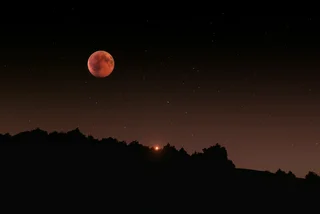Residents of the Czech Republic will be able to witness partial solar eclipse today, visible around midday, with the best viewing conditions in the northwest. This will mark the first time in two years an eclipse has been visible from Czechia.
Astronomers have called today's solar eclipse one of the most visible in recent years, as the sun will be positioned high above the horizon at its peak. While the spectacle promises to be awe-inspiring, experts caution that proper precautions must be taken to avoid eye damage.
The partial eclipse will begin around 11:29 a.m. and last for approximately an hour and a half, with slight variations across the country. In Prague, the eclipse will begin at 11:35 a.m., peak at 12:18 p.m., and end by 1:01 p.m. Observers in other cities, such as Ostrava, will see the event slightly later, with less intensity.
Viewing the eclipse safely
Experts emphasize the importance of using special eclipse glasses or filters when watching the solar eclipse, as direct observation without protection can result in permanent eye damage. Ordinary sunglasses are insufficient for safely viewing the sun. Additionally, telescopes must be equipped with solar filters; without them, they can cause severe eye injuries.
Many observatories, including those in Prague, will be hosting public viewings of the eclipse, offering the chance to witness the phenomenon through specialized equipment and with guidance from experts.
Astronomical institutions such as the Stefanik Observatory and the Ďáblice Observatory in Prague will provide access to solar telescopes for the public, as well as informative sessions about the science behind eclipses. For those unable to attend in person or those facing cloudy skies, live streams of the event will be available online.
The science of a solar eclipse
A solar eclipse occurs when the moon passes between the Earth and the Sun, blocking all or part of the Sun’s light. During today’s partial eclipse, the moon will cover up to 22 percent of the solar disk, which will be most noticeable in the northwest. Although solar eclipses are not rare on a global scale, complete eclipses are far less frequent and more spectacular.
According to astronomers from the Silesian University of Opava and the Czech Astronomical Society, this partial eclipse will be visible over much of Europe, North America, and parts of the Arctic and Atlantic. However, the most significant coverage will occur in Canada, where up to 94 percent of the sun will be obscured.
For those in the Czech Republic, this partial eclipse will be the last chance to witness such an event until August 2026, when a more prominent partial eclipse will occur. The next total solar eclipse visible from the Czech Republic won’t happen until October 2135.
While cloudy weather conditions in some local areas may pose challenges for viewing the eclipse, many local observatories are preparing for an influx of visitors eager to experience this rare celestial phenomenon. More information about local viewing events can be found from the Czech Astronomical Society.












 Reading time: 2 minutes
Reading time: 2 minutes 



























